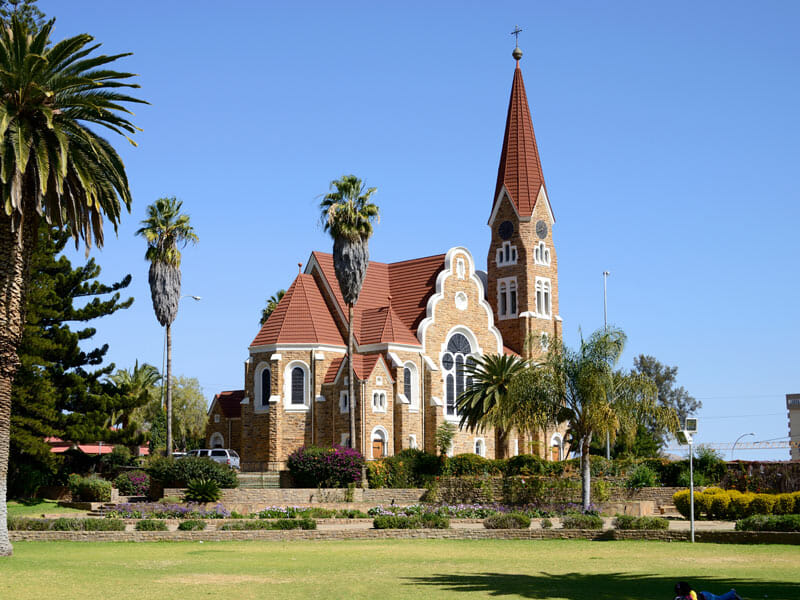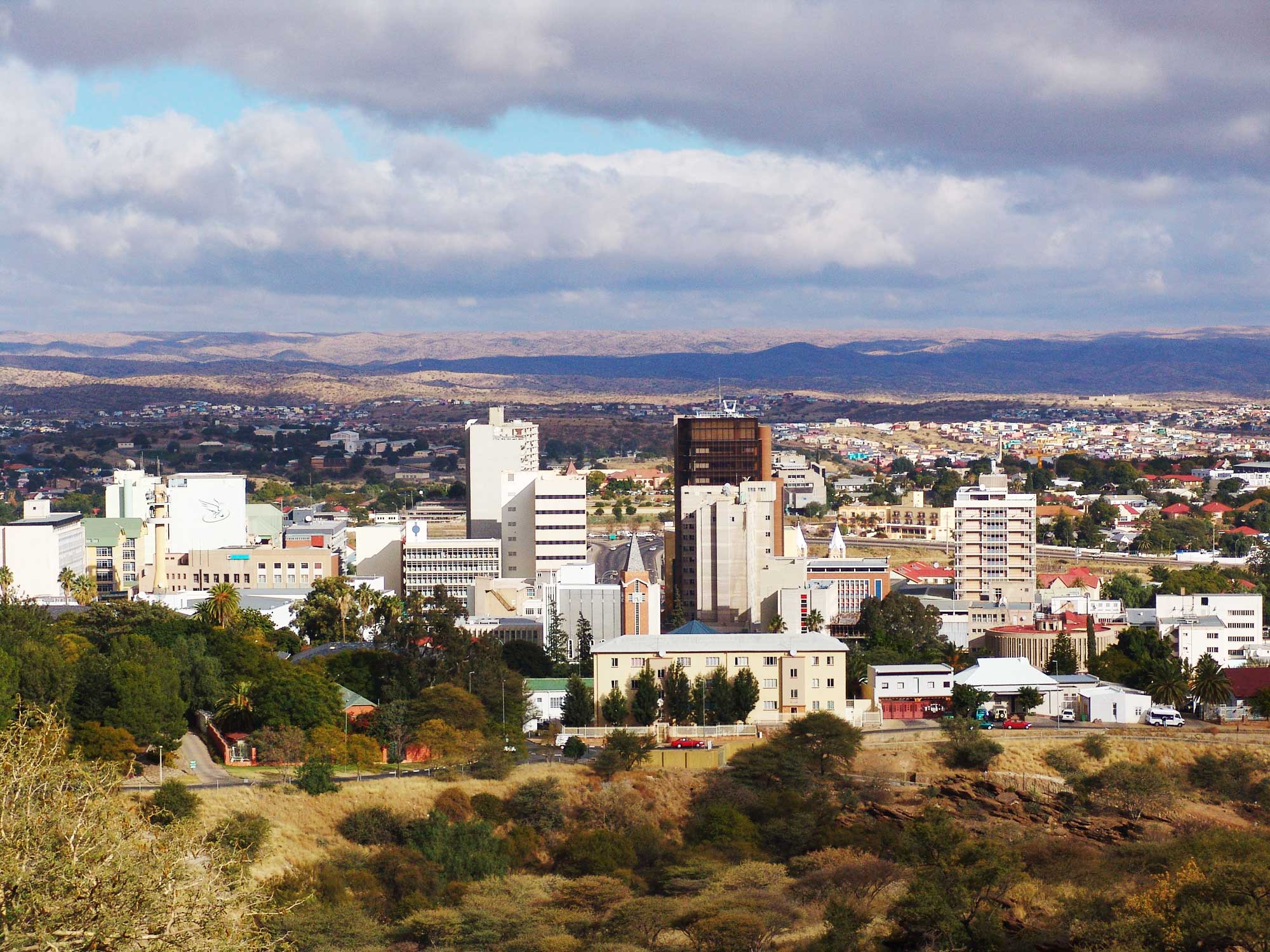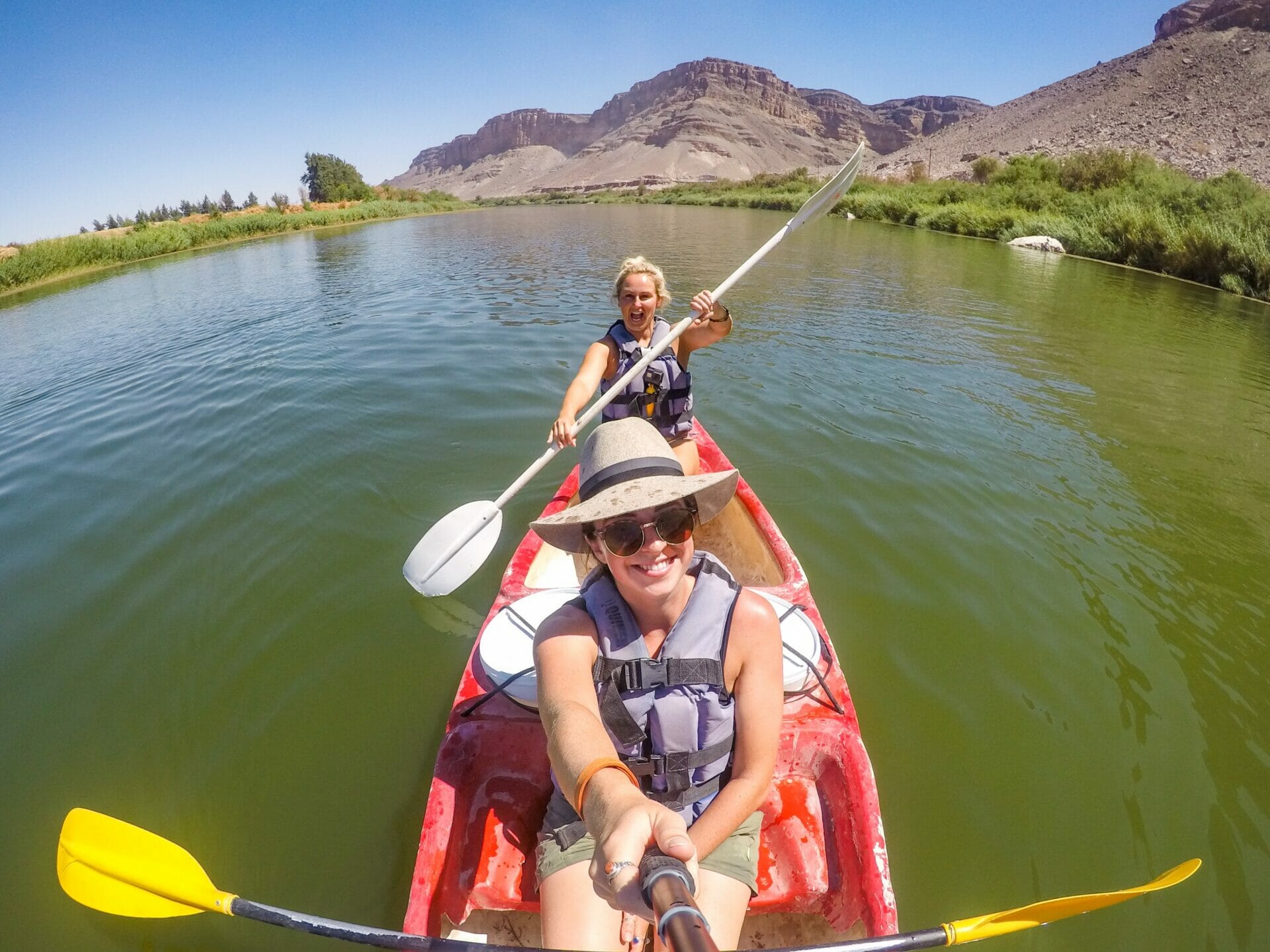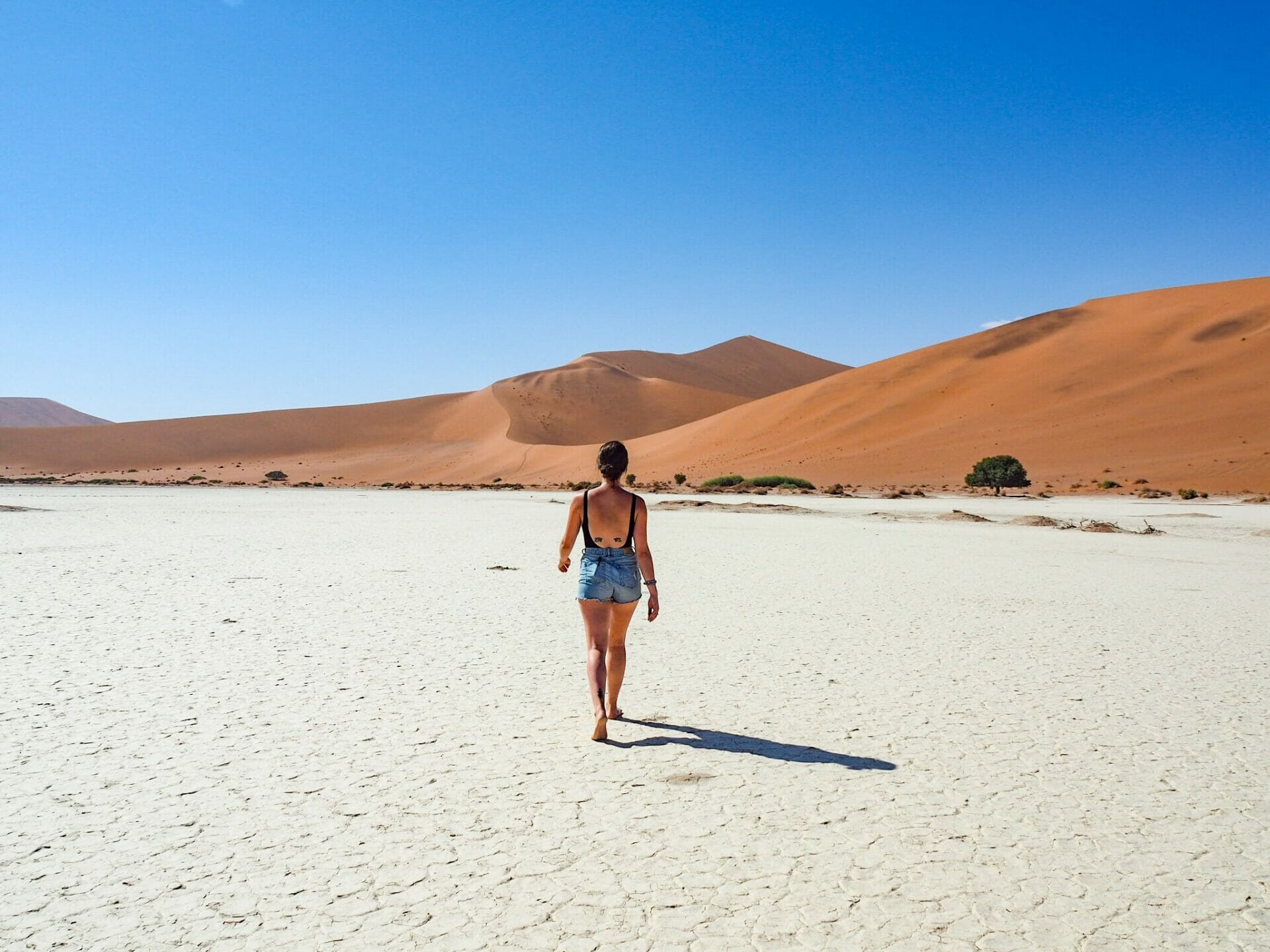
Last Updated on 5 June 2022
Namibia is like no where else in the world. That really struck me as I sat, legs dangling over the world’s second largest canyon, completely alone. Save for my group of friends, there wasn’t another person in sight, and you don’t just almost never find that; you never find that. Something I notice more and more on my travels is just how over-commercialised everything is becoming, often at the expense of authenticity, but never in Namibia. It’s a relatively young country, only gaining independence from a series of colonial rulers in the 90s, but it’s impeccably clean, full of beautiful people, overflowing with unrivalled natural beauty, practically devoid of tourists, and is just waiting to steal your heart. Assuming you’ve already been thoroughly convinced to buy your ticket, here are 8 of the most spectacular spots that you absolutely can’t miss and everything you need to know about visiting on your own Namibia trip.

1 | Dune 45
While it may not be the tallest dune in the sprawling Namib Desert (which is actually home to the tallest dunes in the world), the scenery from Dune 45, so named because it is 45km from the Sesriem Gate, is still stunning. It’s a frustrating 80m climb up alarmingly loose sand that has you sliding back one step for every two that you take upwards, but it shouldn’t take longer than 15 minutes to reach the top and reap the reward: panoramic views over a sea of bright red dunes. The best advice is to go early and beat the midday heat, but bear in mind that the gate doesn’t open until sunrise, so the only way to actually watch the sun come up from the top of the dune would be to camp inside the park.
Cost: A permit for Namib-Naukluft National Park is N$80 for tourists plus N$10 per car, payable at the Sesriem Gate upon entry. This also includes your visit to Deadvlei (see more below).
Getting there: The nearest airport is 5 hours away in Lüderitz. Alternatively, drive 4 hours SW of Windhoek to reach the Sesriem Gate. After passing through the inner gates, Dune 45 is a further 40-ish minutes down the road. Even 2×4 vehicles should be able to make this drive.
Where to stay: Camp inside the park gate at Sesriem Camping, which will allow you to avoid the morning crowds (after the park gates open) and climb Dune 45 for sunrise. Campsites are N$220-240 per person, depending on the season.
Top tip: Climb Dune 45 as early as possible to beat the heat, but leave your shoes behind– socks make the best hiking boots on sand!
Read more: EXPLORING DUNE 45 & DEADVLEI IN THE NAMIB DESERT






2 | Swakopmund
Namibia’s adventure capital, Swakopmund, is situated about midway down the country, flanked by undulating sand dunes on one side and the sparkling Atlantic on the other. This beautiful seaside town feels, at times, more European than African thanks to its upscale waterfront restaurants and distinctly German architecture, a nod to its colonial past, but explore a little further and you’ll find that it’s still African at heart— sand blows across the streets from the nearby desert, artisans hawk the ubiquitous wooden giraffes and elephants at city markets, and camels wander across the road. Go skydiving over the incredible blue and gold landscape, quadbike over the rolling sand dunes, walk through the picturesque streets, visit one of the many craft markets, or just sit on the pier and watch the sunset over the ocean.
Cost: Skydiving is N$2500, quadbiking is around $N800, and there are several dozen other equally exciting activities to partake in.
Getting there: The nearest airport is Walvis Bay, about 30 minutes away. Although it’s not necessary to have a car to enjoy Swakopmund, it is probably still much cheaper to drive here on your way through the country (3 hours west of Windhoek).
Where to stay: Stay in a centrally-located hostel with a tour booking service like Amanpuri or Swakopmund Backpackers. Dorm beds range from N$170-250.
Top tip: Wander down to the waterfront for a beautiful sunset and enjoy an incredible dinner at The Tug.
Read more: WHERE THE DUNES MEET THE SEA: SKYDIVING IN SWAKOPMUND
QUADBIKING THROUGH THE DUNES IN NAMIBIA





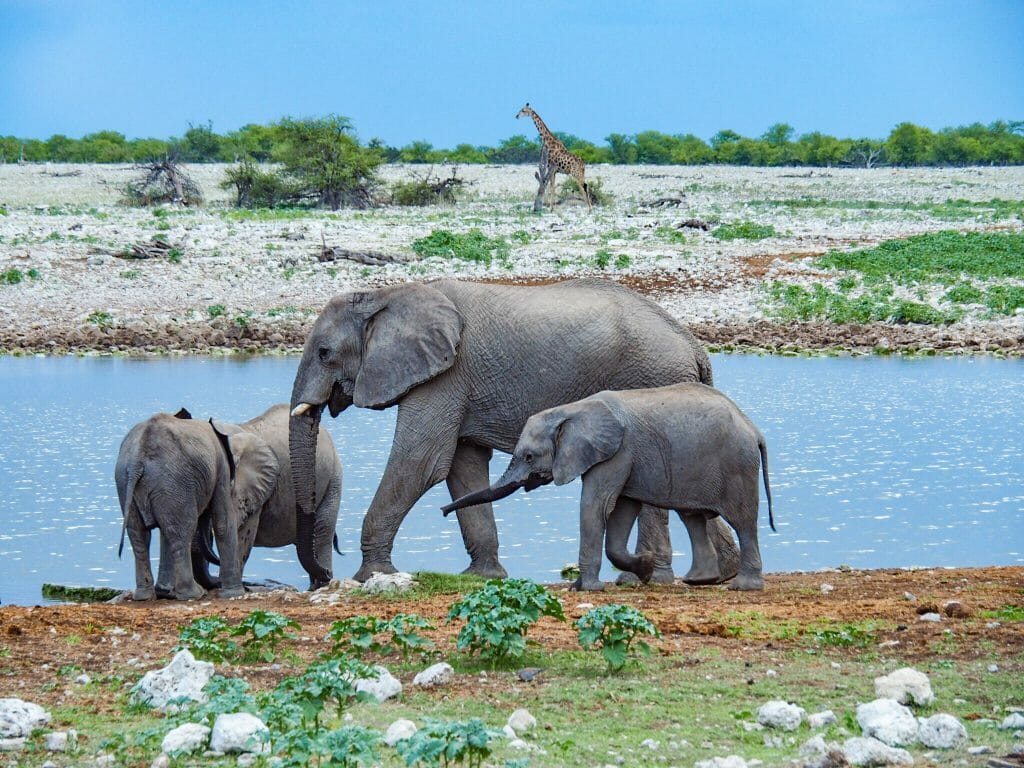
3 | Etosha National Park
For the chance to see big cats, elephants, wildebeest, giraffe, zebra, all types of antelope, hundreds of birds, and the elusive black rhino, self-drive through northern Namibia’s Etosha National Park. Be sure to visit the salt pan in the middle of the park— its glittering white surface is so large that it can be seen from space. Of all the safari camps I stayed in over my travels through Southern Africa, Okaukuejo was a standout for its watering hole that routinely attracts lions, elephants, and black rhino, the last of which I hadn’t yet seen in any other park. There are reasonable camping options, as well as incredible chalets that overlook the happening watering hole, but really it’s just a remarkably underrated national park where you’ll see all of the same African wildlife without nearly the number of tourists.
Cost: An entrance fee of N$80 per person and N$10 per vehicle per day is payable at any of the four entrance gates: Anderson’s Gate (near Okaukuejo), Von Lindequist Gate (near Namutoni Camp), Galton Gate, and King Nehale Lya Mpingana Gate. It is also possible to join guided game drives through one of the camps for around N$600.
Getting there: The nearest airport is Ondangwa Airport (2hrs from Etosha), but it’s also possible to fly into the larger Hosea Kutako International Airport in Windhoek (4hrs from Etosha). Once at the park, drive from one of Etosha’s 6 internal camps to the nearest gate for entry beginning at sunrise, and then enjoy a self-drive safari through one of Southern Africa’s most diverse national parks.
Where to stay: Namutoni, Halali, Okaukuejo, and Olifanstrus all offer camping facilities, while all 6 camps offer chalets (Dolomite and Okonshi being the most luxurious). Camping at Okaukuejo is N$250 per site (8 people max) plus N$136 per person and the amazing chalets overlooking the waterhole range from $N2000-3500 per person sharing.
Top tip: Hang out at the waterhole after dark to see families of elephants and rare black rhinos come for their nightly drink/mating ritual.
Read more: ANIMAL SPOTTING IN NAMIBIA’S ETOSHA NATIONAL PARK






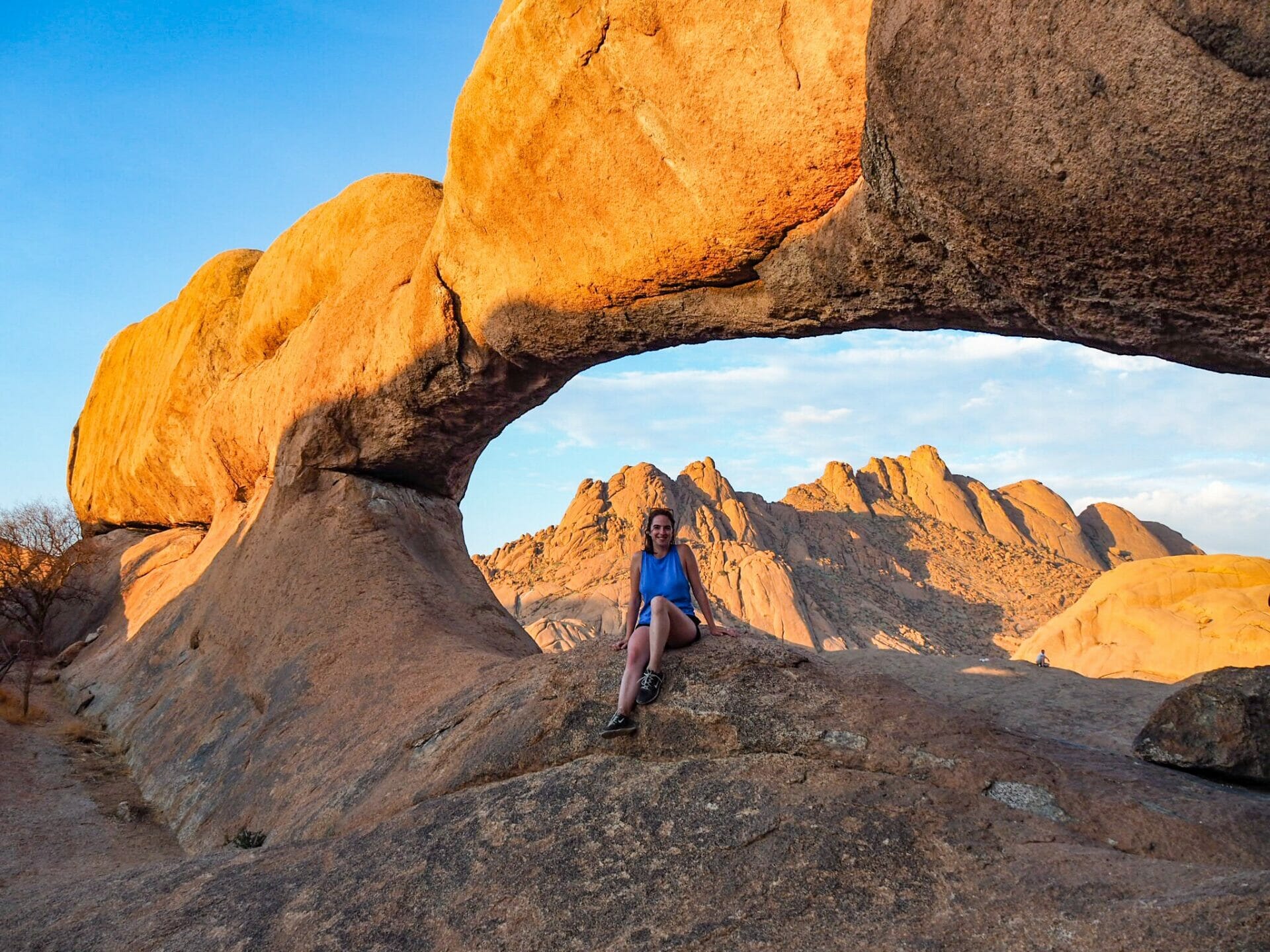
4 | Spitzkoppe
For even more surreal natural beauty, head out to Spitzkoppe, an incredible collection of rocky peaks a couple hours from Swakopmund that look like desert icebergs rising above the otherwise flat terrain. It’s possible to camp right beneath these mountains at a campsite run by the community, but, better yet, haul your sleeping bag and pillow all the way to the top of the rock and sleep under the most spectacular night sky you’ve ever seen. Get yourself to as many different high spots as possible for views that are sure to stun you speechless, and be sure to catch sunrise from the natural rock bridge.
Cost: Join a guided bushwalk around Spitzkoppe for N$55.
Getting there: Drive into the campsite, which is located in the Grosse Spitzkuppe Nature Reserve about 90 minutes NE of Swakopmund or 3 hours NW of the capital, Windhoek. Alternatively, the nearest airport is in Walvis Bay, about 2 hours from Spitzkoppe.
Where to stay: Sites at the Spitzkoppe Community Camp have very basic facilities (drop toilet, no shower, no power, very secluded) and cost N$165 per adult per night.
Top tip: Grab your sleeping bag and pillow, climb up one of the smaller mountains with your head torch, and sleep under the stars.
Read more: SLEEPING UNDER THE STARS IN SPITZKOPPE, NAMIBIA







5 | Fish River Canyon
Prepare to be stunned speechless by southern Namibia’s dramatic Fish River Canyon, the second largest canyon in the world. Even better than the scenery (well, not actually better, but still) is the complete lack of tourists. Explore the rocky rim and its many lookouts utterly alone, and then watch the sunset over the glistening Fish River/Orange River below. You can enter the park near Hobas, from which it is a short drive to some of the main viewpoints (and a reasonable walk to others). There’s a reportedly amazing 5-day hike through the canyon, but you are limited to a narrow window of time in winter/autumn when the weather is agreeable, are required to submit a medical certification and to walk with a group of at least 3 other hikers, and need to be quite fit to handle the demanding conditions. It’s one for the bucket list, for sure!
Cost: Entry into the park is N$80 per person plus N$10 per vehicle, payable in Hobas.
Getting there: Hobas is a 6 hour drive south of Windhoek, or the nearest airport is located about 90 minutes away in Karasburg. After entering the park, continue on another few minutes to reach the first viewpoint.
Where to stay: Camp at the very funky Cañon Roadhouse, just 15 minutes down the road from Fish River Canyon. Sites are N$195 per person, but there are also rooms available for $1355 and up.
Top tip: Make it to the canyon in time to enjoy at least an hour of light before the sun begins to set, that way you get beautiful views into the canyon and the amazingly colourful sunset.
Read more: SUNDOWNERS AT NAMIBIA’S FISH RIVER CANYON





6 | Windhoek
The country’s bustling capital is likely where you’ll start your adventures in Namibia and, although it may not have the dramatic scenery or impressive landscape of other places on this list, it offers an authentic look at modern-day Namibian life and boasts a thriving arts and culture scene that is not to be missed. Go out for fantastic game meat at the popular Joe’s Beerhouse and then go hang out with the locals at the hip live music club, Chopsies, in town. It’s sure to be a memorable visit!
Cost: Game platters at Joe’s Beerhouse run around N$140-190 and are definitely big enough to feed two. Drinks out are in the N$20-50 range.
Getting there: Fly into Hosea Kutako International Airport, located in Windhoek. Although this is the capital city, there is not much in the way of public transport, so I’d recommend hiring a car if you do decide to fly in.
Where to stay: Camp right in the middle of Windhoek at Urbancamp for N$170 (or for N$535 in a pre-erected tent). Facilities include a lively bar, pool, clean showers/toilets, and reasonable WIFI.
Top tip: Check out the city’s nightlife, which is a great opportunity to mingle with some of the locals and see a different side of Namibia. Windhoek is quite safe, but it’s still a good idea to go in a group.
Read more: OUT ON THE TOWN IN WINDHOEK, NAMIBIA
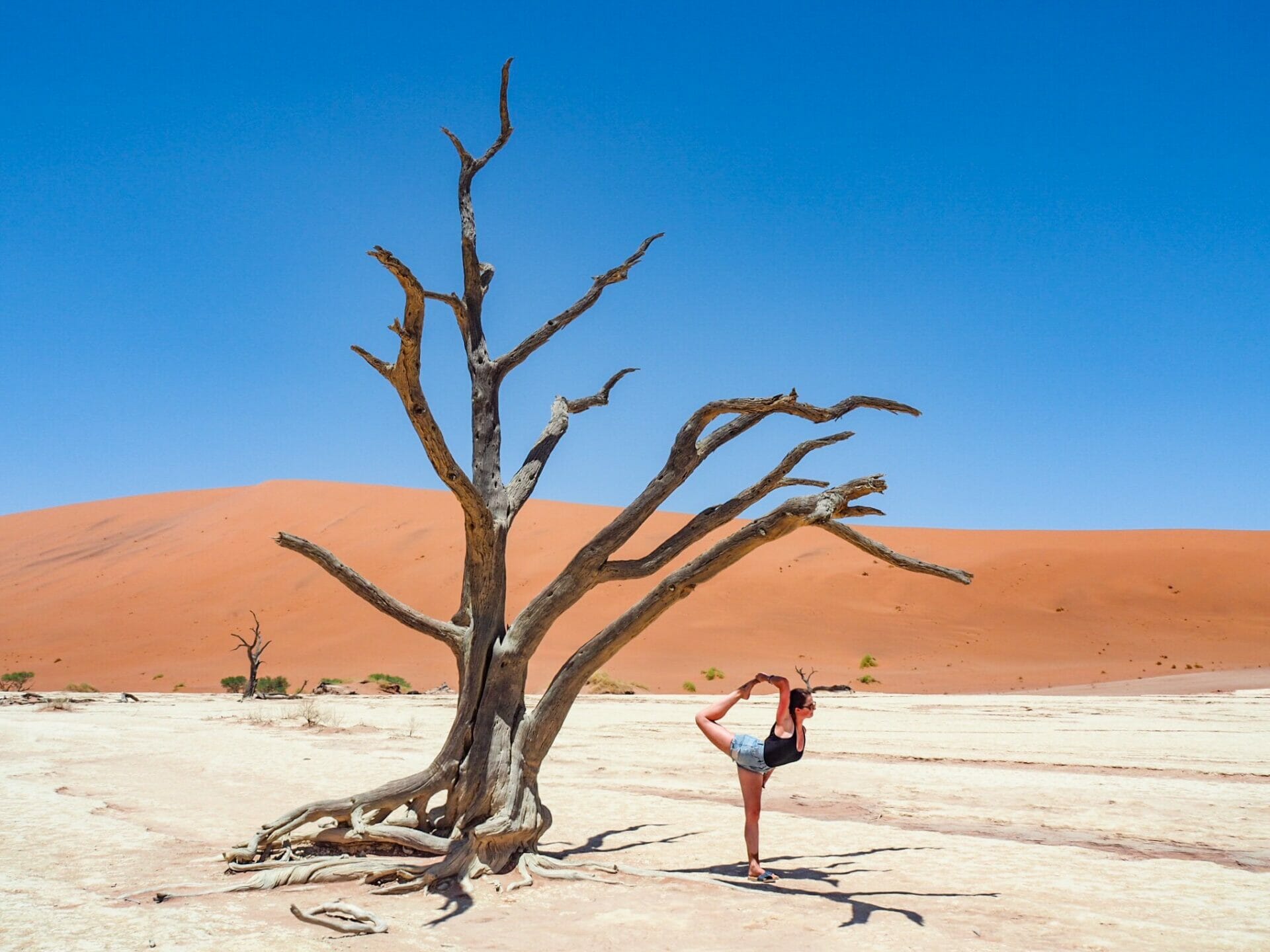
7 | Deadvlei & Sossusvlei
You’ve likely seen photos of this eerie salt and clay pan in the middle of the Namib desert, surrounded by bright orange dunes and covered with gnarly dead trees, but it is truly incredible to lay eyes on in person. From the dunes in Namib-Naukluft National Park, drive only a short way to reach the carpark from which you walk out to Deadvlei (or take a park shuttle if your vehicle isn’t 4WD). The walk across the sand takes about 15 minutes and doesn’t require anything near the climbing necessary to summit Dune 45, but it is still a good idea to start early, as there is absolutely no shade and the sand is hot enough to blister your feet by 10am.
From this same spot, you can also begin your climb up “Big Daddy”, a 380m monster dune that rises far above the rest, but don’t attempt this climb any later than 8am, as the heat is just too extreme and the 2 hour return trip will be agony rather than fun (learn from my mistakes.)
Cost: Entry into Namib-Naukluft National Park, which includes Dune 45 as well as Deadvlei, is N$80 for tourists plus N$10 per vehicle, payable at the Sesriem Gate upon entry.
Getting there: The nearest airport is in Lüderitz, 5 hours from the Sesriem Gate. Alternatively, it is a 4 hour drive SW of Windhoek. Have your permit checked at the inner gates, continue about 40 minutes to pass Dune 45, and then park in the 2×4 parking (if you are not in a 4WD, you will need to take a shuttle the rest of the way to Deadvlei and Sossusvlei). Deadvlei is reached by a further walk across the sand, but the shuttle will drive you right up to the roped-off Sossusvlei.
Where to stay: Camp inside the gate at Sesriem Camping, which will allow you to be the first ones in the park and avoid the morning crowds (after the main gates open at sunrise). Campsites are N$220-240 per person, depending on the season, and a 4×4 shuttle from the car park runs around N$170 per person to transport you to Sossusvlei.
Top tip: If you hope to tackle Big Daddy, skip Dune 45 (or at least come back to it later) so you can take advantage of the cool sand in the early morning before 7am. Again, this is best tackled in socks. Bring plenty of water and sunscreen, this is no small task.
Read more: EXPLORING DUNE 45 & DEADVLEI IN THE NAMIB DESERT





8 | Orange River
Winding between Namibia and South Africa, the Orange River/Fish River passes stunning rocky scenery and is home to what feels like millions of birds. While the afternoon away on a canoe, paddling along this gently-flowing river and taking in all the wildlife along the banks before kicking back at your campsite to enjoy the scenery with a drink in hand.
Cost: Join a 3 hour guided canoe safari with Felix Unite for N$250.
Getting there: The Orange River is a 7 hour drive south of Windhoek, or a 2 hour drive SW from the airport in Karasburg.
Where to stay: Felix Unite Provedance Camp offers beautiful rooms as well as camping facilities right on the Orange River. Sites are N$175 per person, while cabanas run between N$1085-1925 per night.
Top tip: Even if you don’t find yourself on a canoe, make sure to take a dip in this beautiful, shallow river!
Read more: CANOEING ALONG THE ORANGE RIVER



*Practical information
Getting to Namibia
Unless you’re travelling overland from South Africa or Botswana, you’ll probably arrive in Namibia through Windhoek’s Hosea Kutako International Airport. Alternately, there are some flights between Walvis Bay and Cape Town.
Getting around Namibia
The absolute best way to explore Namibia is by car, so don’t even dream of trying to explore the country by internal flights. The most staggeringly beautiful and authentic parts of Africa are located in the middle of no where, so you should either plan to hire a 4×4 with a rooftop tent or join an overlanding tour.
There are heaps of campsites throughout the country, with many located near main attractions like Etosha National Park, Spitzkoppe, and Sossusvlei, so a rooftop tent is a great way to save money. Most overlanding trips also involve camping, and I’d highly recommend it! Because I was travelling alone, I joined a tour with Acacia Africa, which was phenomenal and very reasonably priced.
Travel tips
- Namibia is actually a very safe country and somewhere I’d absolutely recommend to a solo female traveller. Exercise basic common sense and it’s very unlikely you’ll have any negative experiences.
- All signs are in English and pretty much everyone in Namibia speaks English too, so it’s incredibly simple to communicate with the locals and get around.
- There’s malaria risk in some parts of northern Namibia, so consider talking to a doctor about preventatives if you’re spending considerable time around Etosha National Park. Personally, I just used a lot of bug spray during my safari and skipped the meds, but definitely make your own call.
- Namibia accepts both the South African Rand and the Namibian Dollar as legal tender, exchanged at a 1:1 rate. If you’re travelling onwards to South Africa after your time in Namibia, you could make a good argument for just using Rand and avoiding the accumulation of Namibian dollars that will be useless across the border.


